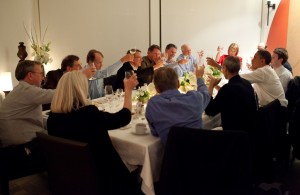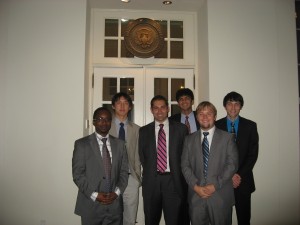My summer working as a software engineer in the federal government
When I began my search for a summer job, working for the government wasn’t on my radar. Like most other computer science students, I looked forward to spending my summer at a sleek, young start-up, hacking web applications with other engineers, coming to work in a t-shirt and jeans, and enjoying the free food. Instead, I opted for the opportunity to work for the Chief Information Officer at the Executive Office of the President (EOP). I was surprised at my own choice but excited to work at the intersection of politics and technology. My summer in DC exposed me to the unique challenges faced by government IT and the shortage of engineers equipped to solve these problems.
The summer program was created by David Gobaud, a Stanford computer science graduate who interned at the Council of Economic Advisers (CEA) last fall. During his time at CEA, he realized that many tasks in the office such as daily spreadsheet updates and data entry could be automated by writing simple scripts in Excel or Word, saving hundreds of hours of time in the long run while simultaneously reducing human error. Recognizing a larger need for engineers to support the entire EOP, he worked with the CIO to create the SoftWare Automation and Technology (SWAT) Team, based on the idea that basic programming knowledge could improve efficiency in the EOP, taking obsolete business processes and improving them with simple applications.
Ultimately, this work isn’t necessarily exciting or ground-breaking from a technological perspective, but it is from the viewpoint of changing how government employees solve everyday problems and approach their work. And therein lies the difficulty of recruiting; engineers in the government, by necessity, are focused on implementing existing and sometimes obsolete technologies rather than inventing new ones, perhaps the primary reason that very few computer science college students work in the public sector upon graduation. Students would much rather move to the Silicon Valley and join the next Google or Facebook than oversee what’s perceived as a clunky government IT system.
Unfortunately, when it comes to IT the government faces its own set of unique challenges that often create problems never experienced in the private sector. The government employs over two million civilians, easily an order of magnitude more than even the largest corporations. And different rules govern data preservation, such as the Presidential Records Act or the Federal Records Act, pieces of legislation which result in varying standards for what software can legally be used to store critical information. Software can take up to two years to procure, simply for legal or security reasons.
In fairness, many of these challenges stem from legitimate concerns. A server outage at Facebook prevents me from viewing my friends’ status updates, while a server outage at the EOP may prevent critical policy memos from being read. And while a private company owes its bottom line to its investors, the government’s “investors,” in some sense, are the entire American citizenry, leaving little tolerance for error or perceived waste. In short the government is not allowed to fail, and perception matters—its employees don’t get to spend 20% of their time working on projects “for fun.” Thus risk-taking, the defining ethic of Silicon Valley start-ups and any inventor for that matter, carries much more severe consequences for the government. The model of a “minimal viable product”—launch first and fix bugs later—cannot be widely used.
But an exciting change is beginning to take place, as a handful of people challenge the notion that the government can’t also be a laboratory for technological experimentation. The Obama Administration has seen the development of Data.gov as well as the Federal IT Dashboard, elegant new websites with the aim of improving government transparency and improving accessibility to public datasets. Programs and events like Code for America, Apps for Democracy, and Reinvent NYC.gov have all been tremendous successes; according to Federal Chief Information Officer Vivek Kundra, a $50,000 investment in Apps for Democracy led to the creation “47 applications…that would have cost about $2.6 million to develop traditionally.” And while these programs are unsustainable as a long-term mechanism to draw engineers into the public sector, their model most closely resembles the entrepreneurial spirit that characterizes the Silicon Valley. They mirror the idea of building applications to proactively solve problems and improve the way government operates, rather than using existing solutions to reactively solve the same problems, after they’ve arisen. The federal government should take these ideas to the next level, by more actively recruiting college students and finding exciting technical challenges for them to solve.
All told, I found working at the Executive Office of the President to be an incredibly unique and truly eye-opening experience. We’ve had weekly meetings with Chief Information Officer, Brook Colangelo, who oversees all the unclassified IT systems in the EOP. We’ve met with Macon Phillips, who is the Director of the Office of Digital Strategies, as well as Vivek Kundra and Aneesh Chopra, who are tasked with identifying ways to use technology to improve existing governmental policy. We’ve built applications for people across the many components of the EOP, in both policy and operational capacities. And we’ve had the amazing experiences of watching President Obama board Marine One and dining in the White House Navy Mess, experiences unique to the EOP.
Most importantly, spending a summer in the federal government has exposed me to the state of technology in the federal government. But this need for greater efficiency presents a tremendous opportunity to anyone looking to tackle serious technical challenges, while performing a very tangible public service. In the future, working in the public sector will be on my radar, and I’d encourage other engineers to do the same.
This article reflects the views of solely Arjun Mody and not those of the Executive Office of the President.
Photo Credit: The White House (flickr)

